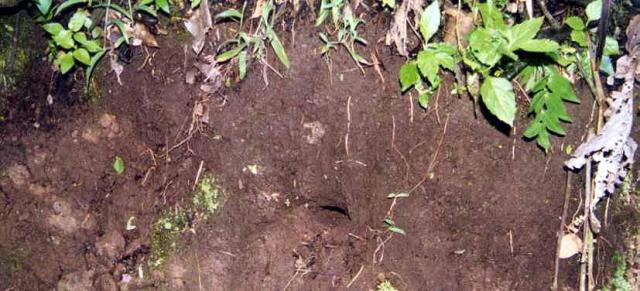Sphaerobothria
Genus Sphaerobothria Karsch, 1879
Genus status. Monotypical genus establishing for a single species - Sphaerobothria hoffmanni, which was described on the base of the female specimens known from the mountain forests of Costa Rica.
Former includes other one species Sphaerobothria gibbosus Bryant, 1940 (transfered from genus Cyrtopholis), which was subsequently transfered back by Schmidt in 1993 (Cyrtopholis gibbosus Franganillo, 1936).
Differs from other genera of subfamily Theraphosinae in the presence of a spheroid foveal process (reminiscent "horn" outgrowth).
Type species - Sphaerobothria hoffmanni Karsch, 1879.
In analogy with spiders of genus Ceratogyrus named "Horned tarantula", since, as well as representatives of mentioned genus has the typical denominated plug at the center of the carapace (fovea). This is one of the several (?) representatives of American fauna of tarantulas, possessing such particularity (the same information is given for several "horned" species of genus Cyrtopholis).
The genus is characterized by the complex of the following taxonomical features: maxillae long, nearly cylindrical and divergent; labium short, broad, trunkated at the apex, which is nearly as broad as the base; sternum small and oval; carapace is a little longer than broad, truncate in front, moderately convex above, caput doesn't rise much nor abruptly from the thoracic level; fovea circular, with large conical outgrowth, occupying the centre; legs are moderately long, strong, femur IV without scopula on the inner side, metatarsus and tarsus scopulated, tarsal scopula not devided by a row of setae; tibia and metatarsus III and IV spinose (the spines more conspicuous in the male), palpi are rather long, strong, similar in color to the legs.
Sexual dimorphism not expressed. Male palpi have the radial joint nearly double the length, and stronger than the cubital, furnished with spines, hairs and bristles; bulb rather obtuse; tibia I with two spurs at the apex beneath.
In nature inhabiting open humid areas of slopes in mountain forests (over 1000 meters above the sea), cultural plantations, road banks (V. Honsa et al., 2004) where dwells in burrows almost to 75 cm in length (there're also data about inhabiting this species a lowlands available).
According the information submitted by Alex Hooijer (Netherlands), personal communication, 2005) in higher elevation they're rather common, burrows can be found sometimes 20 cm from earch other. At nigh time the specimens may be seen sitting at the entrance waiting for food, during the day they're deep within their burrow (at some places this tarantula lives sympatrically with the other local species - Megaphobema mesomelas).
 Sphaerobothria hoffmanni - medium sized terrestrial tarantula, not aggressive but rather shy and nervous, which poison does not present for human any dangers.
Sphaerobothria hoffmanni - medium sized terrestrial tarantula, not aggressive but rather shy and nervous, which poison does not present for human any dangers.
Local effect induced as a consequence of applications of four external secretions from Sphaerobothria hoffmanni was studied in National University, San Jose, Costa Rica (Herrero М.V., 1984). The only local effect microscopically observed was a weak necrosis in the skeletal muscle in mice (herewith, more late studies (1988) of the author with Odell G.V. have found much higher proteolytic activity for digestive secretions).
Keeping. The species Sphaerobothria hoffmanni extremely seldom meets in captivity. The most specimens in collections are wildcaught tarantulas from nature. Single cases of obtaining a spiderlings in captivity are known (V. Honsa et al., 2004). The female has produces an eggsac 3.5 cm in diameter containing 300-400 eggs.
Must be kept under moderate temperature and mildly increased humidity on sligthly moistened substratum.
Distribution. This is the endemic species of mountains of Costa Rica. Noted for provinces Heredia (Cordillera, Volcano Central: Santo Domingo, Santa Rosa, Iglesia), Alajuela (Arenal: Volcano Tenorio, Bijagua, Alberque Heliconias), Cartago, San Jose and Puntarenas.
|
Species |
Common name |
Areal |
Photo |
Biology |
Keeping conditions |
|
hoffmanni |
Costarican horned tarantula |
Costa Rica |
Photo Barry Wiles© 2005
Photo Alex Hooijer© 2002 |
Reaches 5 сm in body length and 10 сm leg span (according some data to 7 cm). |
Kept on 2-5 сm layer of substratum with water bowl and retreat are required. |


